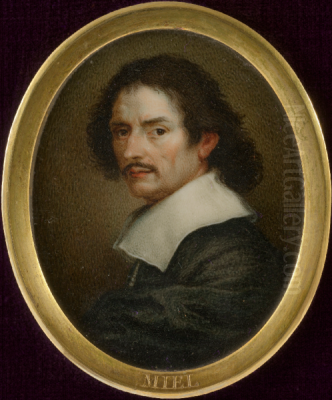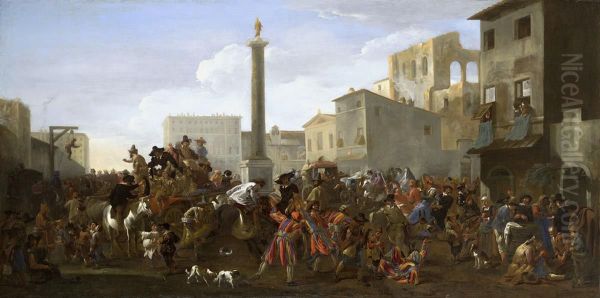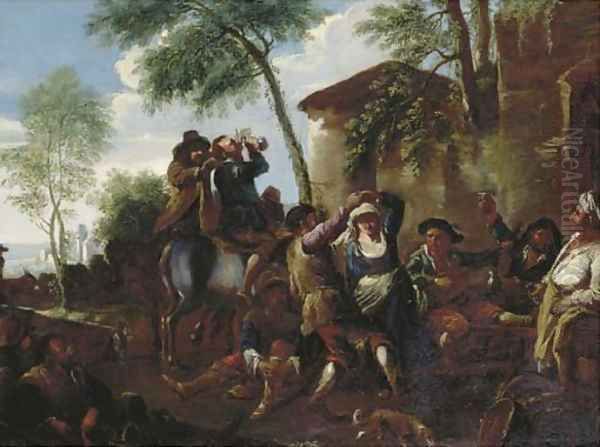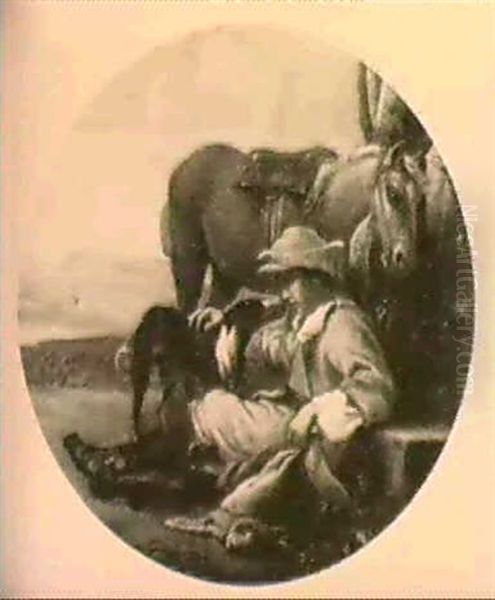
Jan Miel stands as a significant figure in the vibrant artistic landscape of the 17th century. A Flemish painter and engraver, Miel spent the most productive and influential years of his career in Italy, primarily in Rome and later in Turin. Born in 1599 and passing away in 1664, his life spanned a period of immense artistic innovation and change. He is particularly noted for his initial association with the Bamboccianti, painters specializing in scenes of everyday Roman life, before evolving towards a more classical style suited to large-scale historical and religious commissions. This duality makes him a fascinating case study in artistic adaptation and ambition within the complex world of Baroque Italy.
Flemish Roots and Roman Calling
Jan Miel's journey began near Antwerp, likely in Beveren-Waas, Flanders, in 1599. Details of his earliest training remain somewhat obscure, though suggestions sometimes point towards possible apprenticeships in Antwerp, perhaps even briefly encountering figures like Gerard Seghers or Anthony van Dyck, though concrete evidence is lacking. Whatever his initial formation, the lure of Italy, the undisputed center of the art world at the time, proved irresistible.
By around 1636, Miel had established himself in Rome. This city, bustling with artists from across Europe, offered unparalleled opportunities for learning, patronage, and collaboration. Rome was a melting pot of styles, dominated by the grandeur of the High Baroque but also fostering niche genres. It was within one such niche that Miel would first make his mark, immersing himself in the city's vibrant street life and the artistic circles that documented it.
The World of the Bamboccianti
Soon after arriving in Rome, Jan Miel became associated with a group of predominantly Dutch and Flemish artists known as the 'Bamboccianti'. This name derived from the nickname of their perceived ringleader, the Dutch painter Pieter van Laer, who was called 'Il Bamboccio' (meaning 'ugly doll' or 'puppet'), possibly due to a physical deformity. Van Laer specialized in small, meticulously detailed paintings depicting the everyday lives of Rome's lower classes – peasants, artisans, street vendors, travellers, and beggars – often set against picturesque backdrops of Roman ruins or countryside inns.

Miel quickly adopted this style, demonstrating a keen eye for observation and a talent for lively, anecdotal scenes. His Bamboccianti works are characterized by earthy palettes, though often with vibrant accents, strong contrasts of light and shadow, and a focus on the unvarnished reality of common life. He captured market scenes, festivals, travellers resting, peasants dancing, and charlatans plying their trade with an engaging directness.
Works like his famous Carnival in the Piazza Colonna (now in the Prado Museum, Madrid) exemplify this phase. It teems with figures engaged in revelry, showcasing Miel's ability to orchestrate complex multi-figure compositions while retaining individual characterization. Other typical works include scenes of Italian peasants playing cards, resting near ancient ruins, or gathering around itinerant musicians, such as The Charlatan (Hermitage Museum). He brought a distinct Flemish sensibility for detail and texture to these Italian subjects.
Among the Bentvueghels
During his time in Rome, Miel also became a member of the 'Bentvueghels' (Dutch for 'Birds of a Feather'). This was a confraternity, primarily composed of Dutch and Flemish artists working in Rome, known for its bohemian rituals and mutual support system. Membership provided camaraderie and professional connections in a foreign city. Each member received a nickname, often humorous or based on a personal characteristic. While sources vary, Miel's Bentvueghel nickname is often cited as 'Bieco' (Squint-eyed) or perhaps 'Honingh-Bie' (Honey Bee), reflecting his active and productive nature.
His involvement with the Bentvueghels placed him firmly within the community of Northern artists in Rome, a group that included painters like Pieter van Laer himself, Michelangelo Cerquozzi, Johannes Lingelbach, and later Michael Sweerts. These artists often shared themes and sometimes influenced each other's styles, collectively shaping the character of Bamboccianti painting.
Working with the Masters: Andrea Sacchi
Despite his success with genre scenes, Miel harbored ambitions beyond the Bamboccianti style, which, while popular with certain collectors, was often looked down upon by proponents of the 'grand manner' of history painting. An opportunity arose to work with one of the leading exponents of Roman classicism, Andrea Sacchi. Sacchi was a prominent painter favoured by the powerful Barberini family, patrons of Pope Urban VIII.

Miel was employed by Sacchi, likely as an assistant, on the prestigious decoration project for the Palazzo Barberini. Sacchi was responsible for the large ceiling fresco depicting the Allegory of Divine Wisdom (1629-1633). According to accounts, Miel was tasked with painting certain elements, but his ingrained tendency towards realism and perhaps even caricature clashed with Sacchi's classical ideals. One anecdote relates that Miel included figures considered too 'low-life' or 'burlesque' for the dignity of the subject, leading to his dismissal from the project.
While this incident may highlight a stylistic incompatibility at that stage, the association with Sacchi was nonetheless significant. It exposed Miel directly to the principles of Roman classicism and the demands of large-scale fresco decoration, experiences that would prove valuable later in his career. It also demonstrated Miel's growing reputation, even if his genre inclinations initially hindered his acceptance into the highest echelons of Roman art patronage.
Collaborations in Landscape and Architecture
One area where Miel's skills were highly sought after was in providing 'staffage' – the human and animal figures – for the works of specialist landscape and architectural painters. This was a common practice in the 17th century, allowing artists to focus on their strengths. Miel excelled at painting small, lively figures that could animate the often expansive settings created by his collaborators.
He frequently worked with the French landscape painter Gaspard Dughet, brother-in-law of Nicolas Poussin, who specialized in idealized views of the Roman Campagna. Miel's figures added narrative interest and scale to Dughet's atmospheric landscapes. A notable example is the Landscape with Peasants and River, showcasing their combined talents.
Miel is also known to have collaborated with the celebrated master of ideal landscape, Claude Lorrain, another French artist active in Rome. While Claude usually painted his own figures, occasional collaborations occurred, with Miel adding his characteristic staffage to Claude's luminous scenes. Furthermore, Miel worked with architectural painters, known as 'vedutisti', such as Viviano Codazzi and Alessandro Salucci. These artists created intricate depictions of real or imaginary buildings and cityscapes, and Miel's figures populated their piazzas, colonnades, and harbour scenes, bringing them to life. He may have also provided figures for architectural interiors by Flemish specialists like Pieter Neefs the Elder or Younger, though this is less documented during his Italian period.
The Shift Towards Classicism

From the mid-1640s onwards, a noticeable shift occurred in Jan Miel's artistic production. While he didn't entirely abandon genre scenes, he increasingly turned his attention towards more ambitious, large-format history paintings and religious commissions. This transition likely stemmed from a desire for greater prestige and more lucrative patronage, moving away from the often-criticized Bamboccianti style towards the more academically respected 'gran maniera'.
His earlier association with Andrea Sacchi, despite its rocky moments, and the pervasive influence of classical art and theory in Rome undoubtedly played a role. Miel began to adopt clearer compositions, more idealized figures, brighter colours, and themes drawn from mythology, history, and the Bible. His figures became larger and more prominent within the compositions, taking on the heroic or devotional character required by these elevated subjects.
A significant milestone marking this shift and his growing acceptance within the Roman art establishment was his admission into the prestigious Accademia di San Luca in 1648. This official artists' guild was dominated by proponents of classicism, and membership conferred considerable status. It signalled Miel's successful adaptation and his recognition as a versatile artist capable of tackling demanding commissions beyond genre painting.
Major Roman Commissions
Miel's transition to a more classical style bore fruit in the form of significant public commissions in Rome. He participated in the decoration of several important churches, often working alongside other prominent artists. For the church of San Martino ai Monti, he collaborated again with Gaspard Dughet, painting frescoes depicting scenes from the life of St. Elijah, complementing Dughet's landscape settings within the Carmelite church.
He also received commissions for the Palazzo Quirinale, the papal palace, contributing to decorative cycles undertaken during the papacies of Innocent X and Alexander VII. A particularly important independent commission was for the church of San Lorenzo in Lucina, where he painted a large altarpiece, the Assumption of the Virgin. This work clearly demonstrates his mature classical style, with its dynamic composition, idealized figures, and rich colour palette, far removed from his earlier Bamboccianti scenes. He also painted frescoes for the Duomo di San Giovanni in Valetta, Malta, although he likely executed these in Rome.
These large-scale works cemented Miel's reputation as a versatile and accomplished painter in the classical Baroque manner. He proved capable of handling complex narratives and devotional subjects with the requisite decorum and grandeur, successfully navigating the stylistic hierarchies of the Roman art world.
Court Painter in Turin
In 1658, Jan Miel's career took another significant turn when he left Rome for Turin. He was summoned by Charles Emmanuel II, Duke of Savoy, who appointed him as his official court painter ('pittore ducale'). This prestigious position offered financial security and the opportunity to work on major ducal projects. Turin, the capital of the Duchy of Savoy, was undergoing significant urban and architectural development, aiming to emulate the cultural splendour of other European capitals.
Miel's primary task in Turin was to contribute to the decoration of the Reggia di Venaria Reale, a grand hunting lodge and palace complex being built just outside the city. He painted large canvases depicting hunting scenes, allegories, and possibly historical subjects, designed to adorn the palace's lavish interiors. Works like Moses Striking the Rock were created for this context. His style in Turin continued the classical vein developed in Rome, suitable for the aristocratic setting of the Savoy court.
He remained in Turin for the rest of his life, enjoying the duke's patronage and contributing significantly to the artistic embellishment of the Savoyard state. His presence added a cosmopolitan flair to the local art scene, bringing the experience and techniques honed in Rome to the Piedmontese capital.
Miel as an Etcher
Beyond his prolific output as a painter, Jan Miel was also a skilled etcher. He produced a number of prints, often based on his own paintings or drawings. His etchings typically reflect the themes found in his paintings, including genre scenes, pastoral landscapes, and religious subjects. The Flight into Egypt is one of his known etchings, showcasing his ability to translate his painterly concerns into the linear medium of printmaking.
His prints helped to disseminate his compositions and style more widely. Like many artists of the period, Miel understood the value of printmaking not only as an artistic medium in its own right but also as a means of reaching a broader audience and enhancing his reputation beyond the owners of his unique paintings. His etchings display the same lively characterization and attention to detail found in his canvases.
Legacy and Evaluation
Jan Miel died in Turin in 1664, leaving behind a substantial and varied body of work. His artistic journey is remarkable for its successful navigation between the seemingly opposing poles of low-life genre painting and high-minded history painting. He began as a leading figure among the second generation of Bamboccianti, capturing the vitality of Roman street life with Flemish precision and Italian flair. His works from this period remain highly valued for their ethnographic interest and artistic quality.
His subsequent embrace of a more classical Baroque style allowed him to secure prestigious commissions and achieve recognition within the official art institutions of Rome and later at the Savoy court in Turin. While some critics might argue his history paintings lack the profound originality of masters like Poussin or Sacchi, they are nonetheless accomplished works demonstrating his adaptability and technical skill. He successfully integrated lessons from Roman classicism without entirely losing the vivacity that characterized his earlier work.
Miel's influence extended to later genre painters in Italy and the North. His collaborations helped shape the practice of staffage painting in landscape and architectural views. Today, his works can be found in major museums across the world, including the Louvre in Paris, the Prado in Madrid, the Hermitage in St. Petersburg, the Uffizi Gallery in Florence, the Kunsthistorisches Museum in Vienna, and numerous collections in Rome, Turin, and beyond. He remains an important figure for understanding the diverse artistic currents within Italian Baroque art and the significant contributions made by Northern European artists working in Italy. His ability to bridge different genres and styles secures his place as a versatile and significant master of the 17th century.